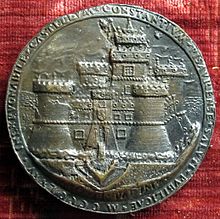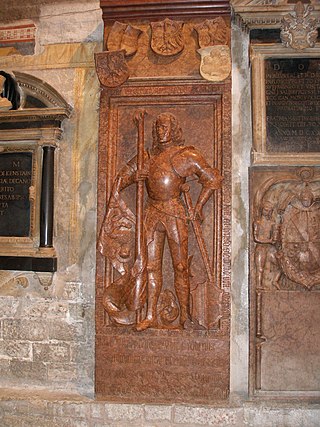

Gianfrancesco Enzola (c.1430, Parma - c.1513) was an Italian medallist, known as il Parmense (the man from Parma). [1]


Gianfrancesco Enzola (c.1430, Parma - c.1513) was an Italian medallist, known as il Parmense (the man from Parma). [1]
He was a son of Luca Enzola, a goldsmith, medallist and mint official in Parma, active between 1455 (when he designed a medal of Pier Maria II de' Rossi, count of Berceto) and 1478 (when he designed a medal of Federico da Montefeltro). Gianfrancesco was trained in his father's studio and by the goldsmith Alessandro da Parma and his son Pietro da Parma, who were active in work for Padua's Basilica of Saint Anthony of Padua.
His first phase lasted from around 1455 to around 1471. It was marked by early attempts to move from casting to minting to produce medals. He and the Venetian Vittore Gambello spearheaded this development. Enzola's early medals are rudimentary, cutting straight into the metal of the small 4 cm diameter negative-matrices from which they would be struck, similar to those already used for coins. This phase included his series for count Pier Maria II de' Rossi and his mistress Bianca Pellegrini, medals for Francesco Sforza and single medals for Cecco Ordelaffi, lord of Forlì (1457) and Taddeo Manfredi, lord of Faenza (1461). They were inspired by the tradition established by Pisanello, showing humanist profile portraits on the recto and a related heraldic or allegoriccal scene on the verso. Their relief was usually very crushed and slightly unclear. [2]
From 1472 to 1473 he was master of the mint at Ferrara. He was not confident in producing medals using coining and so abandoned it in favour of casting. This improved the quality of his medals and increased their level of relief. This second phase from around 1474 to around 1478 included his series for Costanzo I Sforza (1474, 1475, 1478 and other undated examples), considered to be his masterpieces. He also produced several small plaques, a signed seal design for the city of Parma and other unsigned seal designs. His career culminated with a 9.28 cm diameter medal of the condottiero Federico da Montefeltro, known via a two-sided reproduction on the small leather tondoes in the Biblioteca apostolica vaticana. [3]

Ludovico III Gonzaga of Mantua, known as the Turk, also spelled Lodovico was the ruler of the Italian city of Mantua from 1444 to his death in 1478.

Piero della Francesca was an Italian painter, mathematician and geometer of the Early Renaissance, nowadays chiefly appreciated for his art. His painting is characterized by its serene humanism, its use of geometric forms and perspective. His most famous work is the cycle of frescoes The History of the True Cross in the Basilica of San Francesco in the Tuscan town of Arezzo.

The Pazzi conspiracy was a failed plot by members of the Pazzi family and others to displace the Medici family as rulers of Renaissance Florence.

Federico da Montefeltro, also known as Federico III da Montefeltro KG, was one of the most successful mercenary captains (condottieri) of the Italian Renaissance, and lord of Urbino from 1444 until his death. A renowned intellectual humanist and civil leader in Urbino on top of his impeccable reputation for martial skill and honour, he commissioned the construction of a great library, perhaps the largest of Italy after the Vatican, with his own team of scribes in his scriptorium, and assembled around him a large humanistic court in the Ducal Palace, Urbino, designed by Luciano Laurana and Francesco di Giorgio Martini.

A medalist is an artist who designs medals, plaquettes, badges, metal medallions, coins and similar small works in relief in metal. Historically, medalists were typically also involved in producing their designs, and were usually either sculptors or goldsmiths by background. In modern times, medalists are mostly primarily sculptors of larger works, but in the past the number of medals and coins produced were sufficient to support specialists who spent most of their career producing them. From the 19th century, the education of a medalist often began with time as an engraver, or a formal education in an academy, particularly modeling and portraiture. On coins, a mark or symbol signifying the medalist as the original designer was often included in a hidden location and is not to be mistaken for the symbol of the mint master. Artistic medals and plaquettes are often signed prominently by the artist.

Federico I Gonzaga was marquis of Mantua from 1478 to 1484, as well as a condottiero.

Alessandro Sforza was an Italian condottiero and lord of Pesaro, the first of the Pesaro line of the Sforza family.

Bonifacio Bembo, also called Bonfazio Bembo, or simply just Bembo, was a north Italian Renaissance artist born in Brescia in 1420. He was the son of Giovanni Bembo, an active painter during his time. As a painter, Bonifacio mainly worked in Cremona. He was patronized by the Sforza family and was commissioned to paint portraits of Francesco Sforza and his wife Bianca Maria Visconti. Scholars have credited him as the artist who produced a tarot card deck for the Visconti-Sforza families, now held in the Cary Collection of Playing Cards at Yale University. In the past century, art historians have begun to question the authenticity of his works, believing his only two secure works to be the portraits of Francesco and Bianca Maria Sforza. He is believed to have died sometime before 1482.

Giovanni Ambrogio de Predis was an Italian Renaissance painter, illuminator and designer of coins active in Milan. Ambrogio gained a reputation as a portraitist, including as a painter of miniatures, at the court of Ludovico Sforza.

Zanetto Bugatto, also known as Zanetto Bugatti, was one of the most well-documented court portraitists of the 1400s. A key painter of the Lombardy region, Bugatto worked for 15 years for the first two Sforza Dukes of Milan, particularly Duke Galeazzo Maria Sforza and his Duchess Bona of Savoy. His work was influenced by northern artists such as Rogier van der Weyden, Andrea Mantegna, and Jean Fouquet, all of whom he met during his travels. Bugatto's work was described by Galeazzo's ambassador Leonardo Botta as being similar to Sicilian painter Antonello da Messina. It is not clear whether Bugatto painted works other than portraits which he typically made on panel and in fresco. He is notable for being one of the first Italian artists, along with Antonello da Messina, to focus on portraiture in the Netherlandish style to such an exclusive extent.

Sveva da Montefeltro was an Italian beatified nun and noblewoman of the House of Montefeltro. She is venerated by the Catholic Church for her life of devotion despite the hardships she encountered.
Antonio da Montefeltro (1445–1508) was an illegitimate son of Federico III da Montefeltro, duke of Urbino.

Roberto Sanseverino d'Aragona was an Italian condottiero, count of Colorno from 1458 to 1477 and count of Caiazzo from 1460 until his death in 1487. Highly esteemed man of arms, veteran of numerous battles, he was one of the greatest leaders of the Italian Renaissance.

The Marquisate or Margraviate of Mantua was a margraviate centered around the city of Mantua in Lombardy. Ruled by the Gonzaga family from its founding in 1433, it would later be raised to the rank of Duchy in 1530.

Ludovico Gonzaga was an Italian nobleman and condottiero, a member of the House of Gonzaga branch of Sabbioneta.

The Diptych of Federico da Montefeltro and Battista Sforza are two oil paintings by Italian artist Piero della Francesca, dated to 1473–1475. This famed double portrait is often mistitled The Duke and Duchess of Urbino—as it appears on the website of the Uffizi Gallery, which owns it. Since Battista Sforza died in 1472 and Federico da Montefeltro was not made duke until 1474, however, Battista never attained the title of duchess.

The Pesaro Altarpiece is an oil-on-panel painting by the Italian artist Giovanni Bellini, dated to some time between 1471 and 1483. It is considered one of Bellini's first mature works, though there are doubts on its dating and on who commissioned it. The work's technique is not only an early use of oils but also of blue smalt, a by-product of the glass industry. It had already been used in the Low Countries in Bouts' 1455 The Entombment, but this marked smalt's first use in Italian art, twenty years before Leonardo da Vinci used it in Ludovico il Moro's apartments in Milan in 1492. Bellini also uses the more traditional lapis lazuli and azurite for other blues in the work.

Pier Maria Rossi or Pier Maria II de' Rossi was an Italian condottiere and count of a region around present San Secondo Parmense. His properties included the castle of Rocca dei Rossi. He was known as "the Magnificent".

The Bible of Federico da Montefeltro or Bibbia Urbinate is an illuminated manuscript containing the Vulgate text. It was commissioned by Federico III da Montefeltro and produced in Florence between 1476 and 1478. Now, it is housed in the Vatican Apostolic Library.